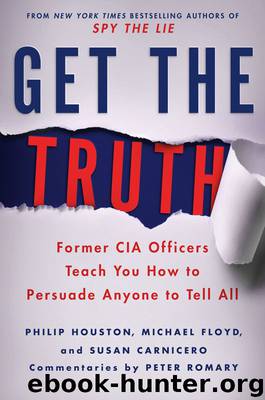Get the Truth: Former CIA Officers Teach You How to Persuade Anyone to Tell All by Philip Houston & Michael Floyd & Susan Carnicero

Author:Philip Houston & Michael Floyd & Susan Carnicero [Houston, Philip]
Language: eng
Format: epub, mobi, azw
ISBN: 9781466841390
Publisher: St. Martin's Press
Published: 2015-03-23T23:00:00+00:00
* * *
LESSONS WE HAVE LEARNED
• Understand that exhaustive preparation is absolutely essential. Know your case facts inside and out, identify the most important issues to cover, and formulate the key questions to ask. Take note of gaps in information, inconsistencies, and things that don’t fit or add up. Prioritize your issues and questions. Cover your most important issues sooner rather than later. That allows you to manage time constraints, and to take advantage of the suspect’s anxiety, which will generally be at its peak at the beginning of the session—the subject will be more likely to exhibit deceptive behaviors that you can analyze. You probably will only have one bite at the apple.
• Have a concrete plan and a well-considered strategy. Identify what it is you want to accomplish. Short of a confession, you must establish specific timelines for the subject’s activities, and details regarding his alibi, injuries, and any other key issues. In other words, lock him in tight to a story. The rule of thumb is to be excruciatingly methodical. This sends the message that you will leave no stone unturned.
• When using more than one questioner, ensure that you identify roles beforehand. One questioner takes the lead, while the other observes, takes notes, and considers follow-up questions—all without interrupting. When the first questioner is finished, he turns to the second questioner and “passes the baton” by saying, “That’s all I have. Do you have anything?” At this point, the roles reverse. The baton passing continues until both questioners are satisfied that the subject has revealed all of the truthful information he intends to disclose. There are advantages to having only one questioner in the room—remember the maxim “People don’t confess to crowds.” The baton passing helps create the sense of a one-on-one, rather than a two-on-one, encounter.
• Briefly apprise the subject of exactly what the issue is, and why you’re talking to him. Cryptic introductions or “hiding the ball” only work in the movies.
• Collect information in chronological order. Otherwise, you’ll risk missing key events or confusing the suspect.
• Don’t accept information at face value. Continually test information with follow-up questions: “How do you know that to be so?” “Why do you say that?” “On what do you base that information?”
• Never be afraid to say, “I don’t understand.” Be absolutely sure to clarify anything that doesn’t make sense to you.
• Ask open-ended questions to solicit a narrative response as a means of establishing the basis for the discussion, or of probing an issue. When asking open-ended questions, allow the subject to answer without interruption—the more information he provides, the greater the likelihood that he’ll make an inconsistent statement or reveal meaningful information. You want to keep the information faucet flowing. Always test the narrative with follow-up questions.
• Ask close-ended questions to gather specific points of data. Example: “What time did you arrive?”
• Use presumptive questions, sparingly, to convey a presumption about something related to the matter under investigation. Use of this type of question helps
Download
Get the Truth: Former CIA Officers Teach You How to Persuade Anyone to Tell All by Philip Houston & Michael Floyd & Susan Carnicero.mobi
Get the Truth: Former CIA Officers Teach You How to Persuade Anyone to Tell All by Philip Houston & Michael Floyd & Susan Carnicero.azw
This site does not store any files on its server. We only index and link to content provided by other sites. Please contact the content providers to delete copyright contents if any and email us, we'll remove relevant links or contents immediately.
We Need to Talk by Celeste Headlee(5487)
Pre-Suasion: A Revolutionary Way to Influence and Persuade by Robert Cialdini(4087)
I Love You But I Don't Trust You by Mira Kirshenbaum(3769)
Captivate by Vanessa Van Edwards(3759)
Goodbye Paradise(3656)
Surrounded by Idiots by Thomas Erikson(3601)
How to Win Friends and Influence People in the Digital Age by Dale Carnegie & Associates(3460)
How to win friends and influence people by Dale Carnegie(3343)
Fluent Forever: How to Learn Any Language Fast and Never Forget It by Gabriel Wyner(2977)
The Dictionary of Body Language by Joe Navarro(2872)
The Hard Questions by Susan Piver(2854)
The Story Factor: Inspiration, Influence, and Persuasion through the Art of Storytelling by Annette Simmons(2504)
Just Listen by Sarah Dessen(2483)
How to Be Yourself by Ellen Hendriksen(2331)
Behave: The Biology of Humans at Our Best and Worst by Robert M. Sapolsky(2229)
The Power of Moments by Chip Heath & Dan Heath(2213)
How to Make Small Talk by Melissa Wadsworth(2151)
Not Nice: Stop People Pleasing, Staying Silent, & Feeling Guilty... And Start Speaking Up, Saying No, Asking Boldly, And Unapologetically Being Yourself by Dr Aziz Gazipura PsyD(2117)
The Small BIG Small Changes that Spark Big Influence by Steve Martin & Noah Goldstein & Robert Cialdini(1835)
